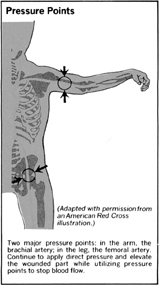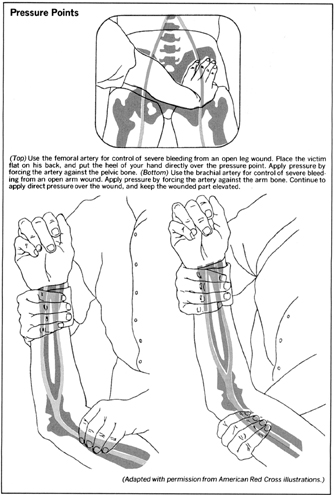The Emergency-Free Home - Severe bleeding
If the victim is not suffering from respiration failure or if breathing has been restored, severe bleeding is the second most serious emergency to attend to. Such bleeding occurs when either an artery or a vein has been severed. Arterial blood is bright red and spurts rather than flows from the body, sometimes in very large amounts. It is also more difficult to control than blood from a vein, which can be recognized by its dark red color and steady flow.
Emergency Treatment
The quickest and most effective way to stop bleeding is by direct pressure on the wound. If heavy layers of sterile gauze are not available, use a clean handkerchief, or a clean piece of material torn from a shirt, slip, or sheet to cover the wound. Then place the fingers or the palm of the hand directly over the bleeding area. The pressure must be firm and constant and should be interrupted only when the blood has soaked through the dressing. Do not remove the soaked dressing . Cover it as quickly as possible with additional new layers. When the blood stops seeping through to the surface of the dressing, secure it with strips of cloth until the victim can receive medical attention. This procedure is almost always successful in stopping blood flow from a vein.

If direct pressure doesn't stop arterial bleeding, two alternatives are possible: pressure by finger or hand on the pressure point nearest the wound, or the application of a tourniquet. No matter what the source of the bleeding, if the wound is on an arm or leg, elevation of the limb as high as is comfortable will reduce the blood flow.

Tourniquets
A tourniquet improperly applied can be an extremely dangerous device, and should only be considered for a hemorrhage that can't be controlled in any other way.
It must be remembered that arterial blood flows away from the heart and that venous blood flows toward the heart. Therefore, while a tourniquet placed on a limb between the site of a wound and the heart may slow or stop arterial bleeding, it may actually increase venous bleeding. By obstructing blood flow in the veins beyond the wound site, the venous blood flowing toward the heart will have to exit from the wound. Thus, the proper application of a tourniquet depends upon an understanding and differentiation of arterial from venous bleeding. Arterial bleeding can be recognized by the pumping action of the blood and by the bright red color of the blood.
Once a tourniquet is applied, it should not be left in place for an excessive period of time, since the tissues in the limb beyond the site of the wound need to be supplied with blood.

Comment about this article, ask questions, or add new information about this topic: